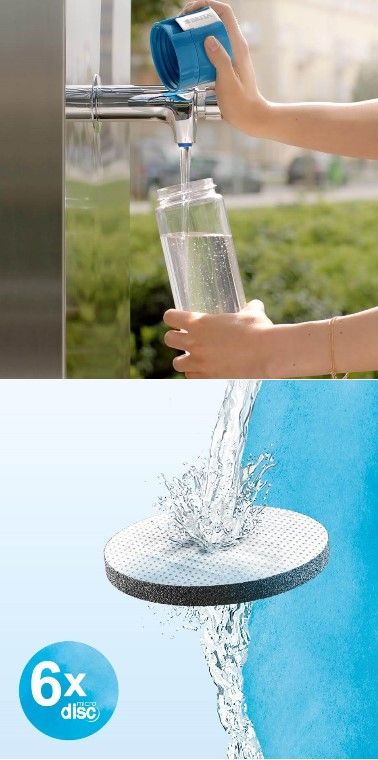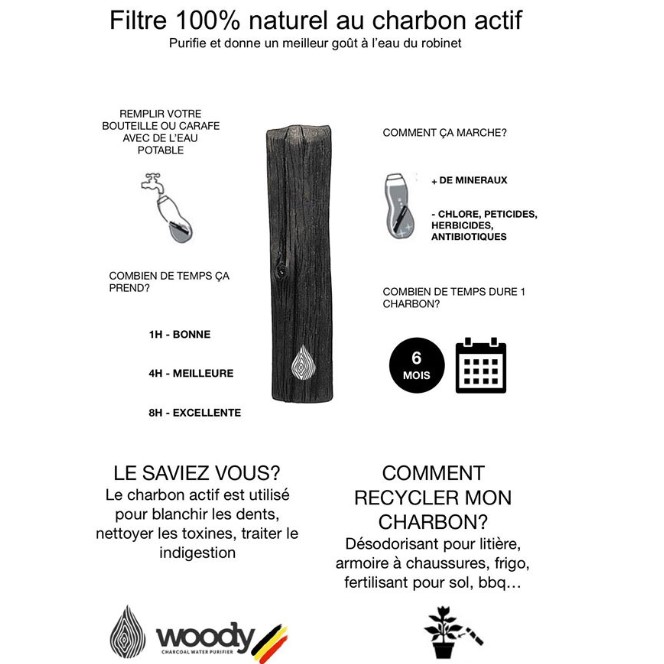Hiking is an activity that is as good for your mind as it is for your body. It allows you to get some fresh air, discover breathtaking landscapes and have a great time alone or with others.
If you are going on a hike for several hours or even days, it is essential to stay well hydrated. However, drinking water directly from a river or lake can be hazardous to your health. It is therefore important to filter your water if you don't want to carry kilos of water.
In this article we look at the risks of not filtering your water and the best filtering systems when you are out hiking.
Contents
What are the sources and risks of water pollution when you go hiking?
Chemical pollution
Biological pollution
Radiological pollution
What are the most effective filtering techniques for your hikes?
Brand new, the portable filter carafe for your hikes
A zero waste water filter for hiking?
And much more about water filtration...
What are the sources and risks of water pollution when you go hiking?
To understand why you should filter your water when you go hiking, let's start with the different sources of water pollution:
Chemical pollution
This pollution is often encountered downstream of human activities (e.g. industrial or agricultural) but it can also be natural due to the type of soil or sediment naturally present.
So, if you are hiking at altitude, you are less likely to encounter this type of pollution from natural sources. On the other hand, there can still be pollution, so be careful! [1]
Biological pollution
This pollution is often found in rivers, both upstream and downstream. Various biological organisms can be found in our waterways [1,2]:
Viruses : some viruses can survive in water and when you drink them, develop and cause nausea, diarrhoea, headaches, ... Viruses are between 10 and 300 nm in size (1 nanometre = 1/1,000,000,000 metre, which is really not very big!)
Bacteria : These can live in water and are mainly of human or animal faecal origin such as Salmonella or Escherichia coli. These bacteria can cause fever, diarrhoea, vomiting and abdominal pain. Bacteria are 0.5 to 5 µm in size (1 micrometre = 1/1,000,000 metre, therefore larger than viruses) [3,4].
Other organisms such as protozoa, fungi, algae, etc.
Radiological pollution
If you go hiking near Chernobyl, for example, you could end up with radiological particles in your water. Otherwise, this type of pollution is not usually encountered [2].
To conclude, although water is essential for our survival, it can also be the source of certain health risks (even if the water is translucent). Hence the importance of water filtration.
What are the most effective filtering techniques for your hikes?
In addition to the Brita or Berkey water filter, there are a number of portable water filters that can easily be taken on a hike. Here is a list of the different water filter families for you with their advantages and disadvantages!
|
Type |
Gravity filter |
Filter by pump |
Straw filter |
|
Technique |
Gravity is used to collect particles with the help of a filter cartridge |
The pump pulls the water through a filter before it reaches the water pocket |
The straw consists of a ceramic or glass fibre filter with very fine pores |
|
Benefits |
Filters a large quantity of water in a short time |
Effective for all types of pollution (viruses, bacteria, particles, protozoa) |
Very light, space-saving, easily transportable |
|
Drawbacks |
Find a place to hang the filter Not all are effective for viruses (check carefully!) |
Pumping requires energy and can be tiring. The pump filter is bulky |
No protection against viruses |
|
Price |
Between 50 and 250 euros |
Between 100 and 350 euros |
About 25 euros |
The portable carafe filter for your hike
Brita has followed the demands of their customers and designed a 600ml filtering bottle. They've done a great job! You can now take your filtered water with you on a walk, just like in your Brita carafe. The MicroDisc filter is 100% recyclable like all Brita filters (if you return it to your local sales or collection point of course), the filter retains chlorine and other substances that can alter the taste, fine particles and it reduces impurities such as certain pesticides, herbicides and hormones. You can filter up to 60L of water, so you can enjoy your hikes with purified, good and safe water. Filtration is immediate. Still, Brita advises to use it for tap water.
A zero waste water filter for hiking?
You can use a charcoal filter (also called Binchotan) in your water bottle for your hikes, but when you take water, you have to wait at least one hour before drinking it for the charcoal to take effect. It is therefore interesting to have two bottles: one that is being purified and one that is already purified and that you can drink. As with the filter bottle, it is advisable to use this type of filter with tap water.
And much more about water filtration...
So be sure to choose your water filter according to where you are going and in what conditions. I hope this article on hiking water filters has been helpful. And as it is better to be well informed about the water you drink, the following articles should interest you:
Bibliographic resources
[1] https://www.isere-rando.com/technique/comment-purifier-eau-randonnee/
[2] https://www.randonner-malin.com/fontaine-je-ne-boirai-pas-de-ton-eau-sauf-si-elle-est-purifiee/
[3] https://www.pasteur.fr/fr/centre-medical/fiches-maladies/salmonellose
[4] https://www.pasteur.fr/fr/centre-medical/fiches-maladies/escherichia-coli

Titi the Elk
Take care of yourself and your planet

.jpg?access_token=040e37ef-f30c-4fe8-9610-217913a4df38)

